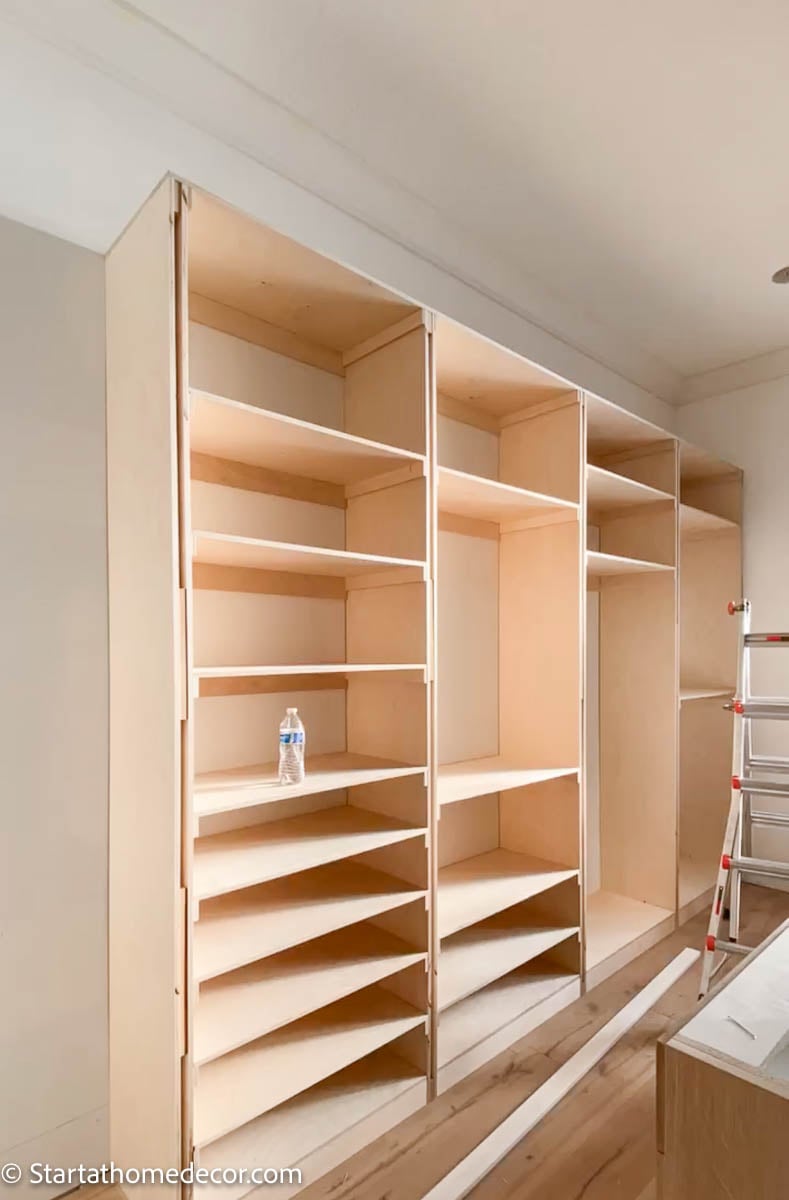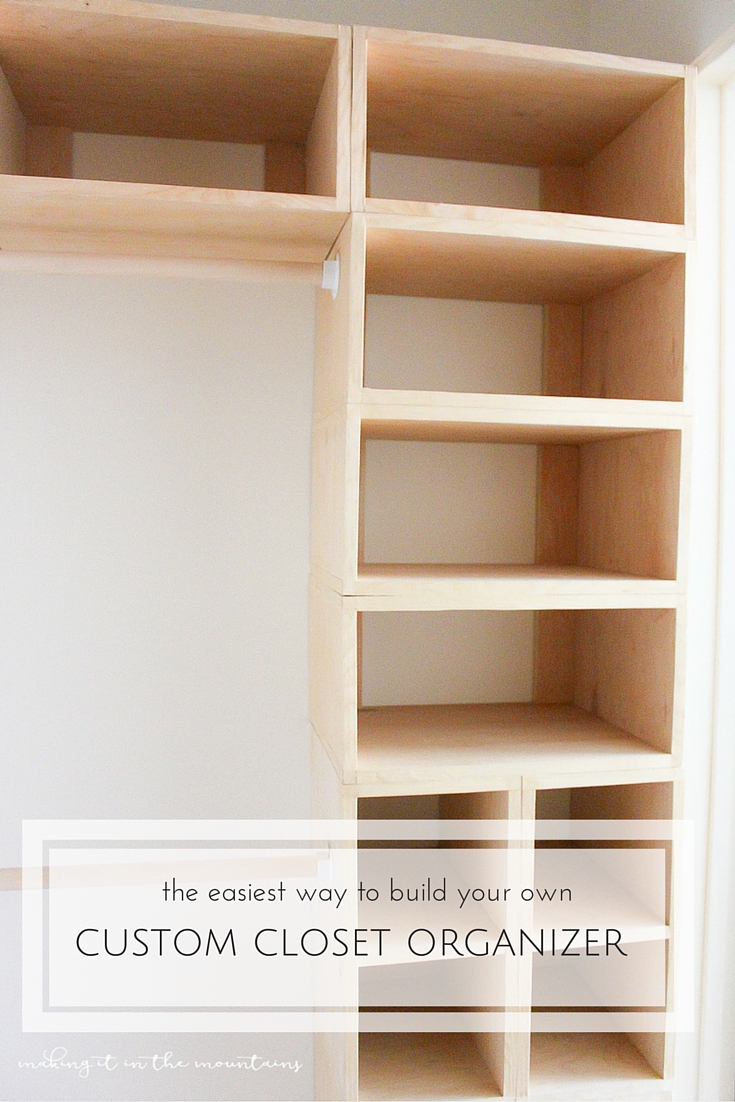To build a custom closet, measure the space, choose materials, plan the layout, and assemble the components. Creating a custom closet allows you to maximize storage and organization while fitting the space perfectly.
Whether you’re building a closet from scratch or revamping an existing one, customizing the design ensures that it meets your specific needs and preferences. There are various options for materials, configurations, and accessories to consider, so a well-thought-out plan will result in a functional and aesthetically pleasing closet.
By following the steps and tips for building a custom closet, you can achieve a personalized and efficient storage solution in your home. With careful measurements, thoughtful design, and quality materials, you can create the ideal custom closet for your space.

Credit: nlovewithjasmine.com
Choosing The Right Design
In the process of building a custom closet, choosing the right design is essential. It’s important to consider the available space, organizational needs, and personal style. By carefully assessing these factors, you can create a closet that maximizes functionality and enhances the overall aesthetic of the space.
Assess Your Needs
Identify your storage requirements: clothes, shoes, accessories.
Consider Your Space
Evaluate the dimensions and layout of your closet area.
Analyze Your Budget
Determine a budget that aligns with your customization needs.
Measuring And Planning
When it comes to building a custom closet, starting with measuring and planning is crucial for a successful project.
Take Accurate Measurements
Measure the available space to determine the dimensions for the new custom closet.
Determine Storage Requirements
Assess your storage needs and decide how much space you need for hanging clothes, shelves, and drawers.
Create A Detailed Plan
Sketch a detailed plan for your custom closet, noting the placement of rods, shelves, and storage units.
Selecting Materials And Tools
Selecting the right materials and tools is an essential step in building a custom closet. By choosing high-quality materials and gathering the necessary tools, you’ll ensure a sturdy and professional finish. In this section, we’ll discuss the importance of selecting high-quality materials and provide a comprehensive list of the tools you’ll need to complete the job.
Choose High-quality Materials
When building a custom closet, it’s crucial to choose materials that will withstand daily use and provide durability. Opting for high-quality materials ensures that your closet will last for years to come. Here are some key considerations:
- Wood: Select a sturdy wood such as plywood or solid wood for the closet structure and shelves. These materials are robust and less prone to warping or sagging.
- Hardware: Invest in high-quality hardware like hinges, drawer slides, and handles. These components are subject to frequent use, so durability is paramount.
- Finishing materials: Choose paint or stain that is specifically designed for wood surfaces. This will provide a protective layer and enhance the appearance of your custom closet.
- Accessories: Consider additional features like shoe racks, hooks, or pull-out drawers. Ensure these accessories are made from durable materials to withstand constant use.
Gather The Necessary Tools
Before starting the construction process, it’s vital to have the right tools at your disposal. Here is a comprehensive list of the tools you’ll need:
| Tools | Function |
|---|---|
| Measuring tape | To obtain accurate measurements for the closet structure. |
| Circular saw | For cutting the wooden boards to the required dimensions. |
| Power drill | To drill holes for screws and secure the structure together. |
| Screwdriver set | For driving screws into the wooden boards. |
| Level | To ensure the closet structure is straight and balanced. |
| Chisel | For precise trimming of wood or mortising hinges. |
| Sanding block | To smoothen rough edges and prepare the wood for finishing. |
| Paintbrush or roller | To apply paint or stain to the wooden surfaces. |
Having these tools readily available will make the building process much smoother and efficient.

Credit: southernyankeediy.com
Building The Closet Frame
Building the closet frame is an essential step in creating a custom closet that maximizes space and organization. The frame provides the structure and support for the shelving and hanging rods, ensuring a sturdy and functional closet system. Below are the key steps involved in building the closet frame.
Start With The Base
To begin building the closet frame, start by constructing the base. Use sturdy and level materials such as plywood or MDF to create a solid foundation for the closet. The base should be installed securely to the floor to ensure stability and prevent any movement or wobbling.
Install Side Walls
Next, install the side walls of the closet frame. Measure and cut the materials to fit the desired dimensions of the closet space, ensuring that the walls are plumb and aligned correctly. Secure the side walls to the base with screws to create a strong and stable framework.
Add Back And Top Supports
With the base and side walls in place, add back and top supports to reinforce the structure of the closet frame. These supports will help distribute the weight of the shelving and hanging rods evenly, preventing any sagging or bowing over time. Use sturdy brackets and screws to secure the supports in position, ensuring they are level and securely attached.
Installing Shelves And Hanging Rods
Once you have designed and prepared your custom closet, the next step is to install shelves and hanging rods to fully maximize your storage space. Properly placing and securing these elements will ensure the functionality and efficiency of your custom closet.
Determine Shelf And Rod Placement
Begin by determining the ideal positioning of the shelves and hanging rods within your closet. Consider the items you plan to store and organize, and visualize how they will best fit and be accessible. Take measurements and mark the locations to guarantee accurate installation.
Install Shelf Brackets
Once you have determined the placements, the next step is to install the shelf brackets. Use a level to ensure the brackets are perfectly aligned, and securely attach them to the closet walls. It’s crucial to follow the manufacturer’s guidelines for weight capacity and spacing to guarantee the stability of the shelves.
Attach Hanging Rods
After securing the shelves, the final task is to attach the hanging rods. Determine the desired height for the rods based on the types of clothing you will be hanging. Make sure to use a stud finder to locate and attach the rods to the closet walls for optimal strength and support.
Adding Custom Features
When it comes to building a custom closet, it’s all about creating a space that not only meets your storage needs but also incorporates personalized features. These custom additions can make your closet more functional, organized, and visually appealing. In this section, we will explore three essential custom features that can take your closet to the next level:
Incorporate Drawers Or Baskets
Adding drawers or baskets to your custom closet is a game-changer. They provide a practical storage solution for items such as socks, underwear, accessories, and folded clothes. Not only do drawers keep everything neat and tidy, but they also make it effortless to find what you need without rummaging through piles of items. To maximize space, consider choosing stackable drawers that can be easily pulled out and rearranged. Labeling each drawer can save precious time during your daily routine, ensuring everything has its designated spot.
Include Shoe Racks Or Hooks
Shoes can easily clutter up a closet, leading to a disorganized mess. Incorporating shoe racks or hooks is a smart and efficient way to keep your footwear collection well-organized. Shoe racks are available in various styles, including free-standing, wall-mounted, and hanging options. Depending on your closet space, opt for a style that fits your needs. If you’re short on floor space, wall-mounted racks or over-the-door shoe organizers are excellent choices. Hooks can also be added to hang sandals, boots, or belts, freeing up shelf space and keeping your shoes easily accessible.
Consider Lighting Options
Proper lighting is crucial when it comes to showcasing the contents of your closet and ensuring everything is visible. Including lighting options such as LED strips or overhead lights can make a significant difference in your closet’s functionality and aesthetic appeal. LED strips installed above clothing rods or inside drawers provide ample illumination, making it easier to choose your outfit or find specific items in dark corners. Overhead lights, such as track lighting or recessed fixtures, create an overall well-lit space, eliminating any shadows or dim areas.
By incorporating these custom features into your closet, you can create a storage space that not only meets your unique needs but also adds a touch of personalized style. The addition of drawers or baskets, shoe racks or hooks, and proper lighting options will transform your closet into a functional and visually appealing room that you’ll enjoy using every day.
Finishing Touches
When it comes to building a custom closet, the finishing touches can make a significant impact on the overall look and functionality of the space. Finishing touches play a crucial role in completing the project and giving the closet a polished appearance.
Paint Or Stain The Closet
- Choose a paint or stain color that complements the existing decor.
- Apply the paint or stain evenly for a professional finish.
- Allow sufficient drying time between coats for best results.
Apply A Protective Coating
- Protect the closet from everyday wear and tear with a clear coat or sealant.
- Ensure even coverage of the protective coating for long-lasting durability.
- Follow the manufacturer’s instructions for application and drying times.
Add Hardware And Accessories
- Select hardware such as handles, knobs, and hooks that match the style of the closet.
- Install hardware securely to ensure functionality and stability.
- Incorporate accessories like bins, baskets, and dividers for organization.
- Customize the accessories to maximize storage and optimize space utilization.
Optimizing Storage Space
Utilize Vertical Space: Install shelves or hanging organizers to maximize space.
Use Organizers and Dividers: Sort items by category using dividers for efficient storage.
Maximize Underutilized Areas: Utilize the back of doors or corners for extra storage options.

Credit: startathomedecor.com
Frequently Asked Questions For How To Build A Custom Closet
How Can I Design A Custom Closet Layout?
To design a custom closet layout, start by measuring the space, determining your storage needs, and creating a layout plan. Consider factors such as shelving, hanging space, and drawers to maximize functionality and organization.
What Materials Are Best For Building A Custom Closet?
For building a custom closet, consider using durable materials like hardwood, plywood, or melamine. These materials offer strength and longevity while providing a polished and professional finish to your custom closet design.
What Are The Essential Tools Needed For Building A Custom Closet?
Essential tools for building a custom closet include a tape measure, level, drill, saw, and screwdriver. Additionally, you may need hardware such as shelf brackets, rods, and drawer pulls to complete the installation of your custom closet system.
Conclusion
Building a custom closet is a practical and rewarding project that allows you to maximize space and organize your belongings efficiently. By following the step-by-step guide we’ve provided, you can create a personalized storage solution tailored to your specific needs.
Remember to carefully plan, measure, and choose the right materials and tools to ensure a successful outcome. With patience and dedication, your custom closet will not only enhance the functionality of your space but also add value to your home.
Happy building!
{ “@context”: “https://schema.org”, “@type”: “FAQPage”, “mainEntity”: [ { “@type”: “Question”, “name”: “How can I design a custom closet layout?”, “acceptedAnswer”: { “@type”: “Answer”, “text”: “To design a custom closet layout, start by measuring the space, determining your storage needs, and creating a layout plan. Consider factors such as shelving, hanging space, and drawers to maximize functionality and organization.” } } , { “@type”: “Question”, “name”: “What materials are best for building a custom closet?”, “acceptedAnswer”: { “@type”: “Answer”, “text”: “For building a custom closet, consider using durable materials like hardwood, plywood, or melamine. These materials offer strength and longevity while providing a polished and professional finish to your custom closet design.” } } , { “@type”: “Question”, “name”: “What are the essential tools needed for building a custom closet?”, “acceptedAnswer”: { “@type”: “Answer”, “text”: “Essential tools for building a custom closet include a tape measure, level, drill, saw, and screwdriver. Additionally, you may need hardware such as shelf brackets, rods, and drawer pulls to complete the installation of your custom closet system.” } } ] }
